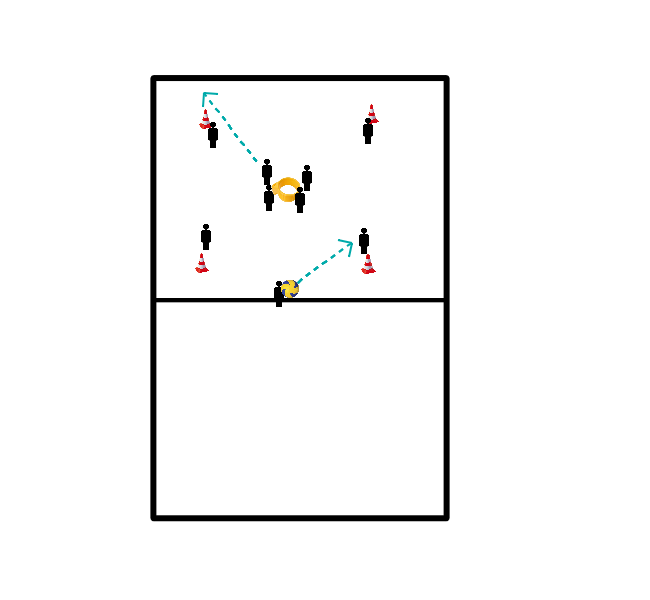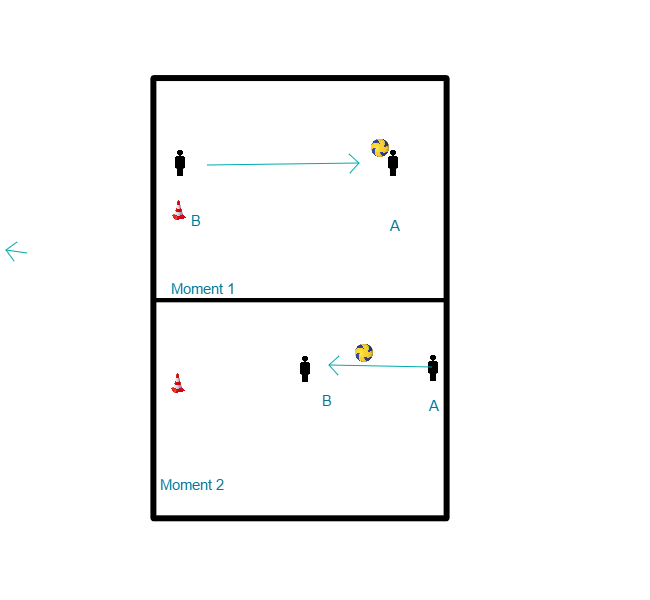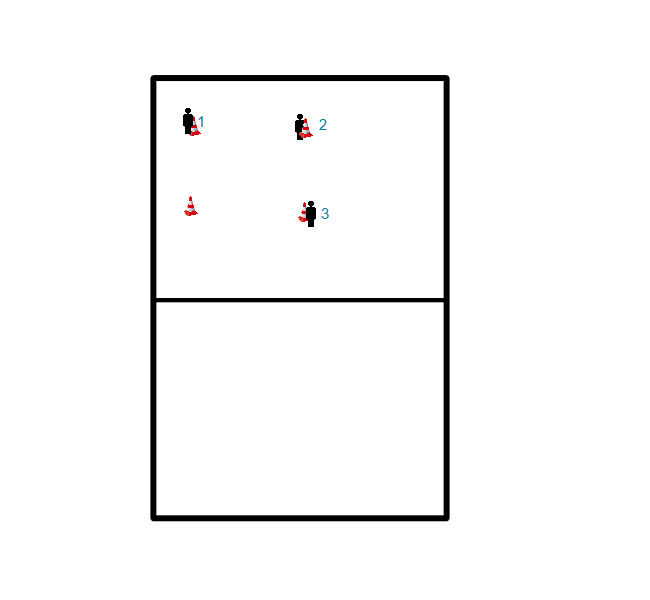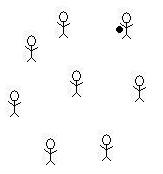Korfball drills for technique passing / attack
Inshort: basic exercise with pairs to learn or improve throwing and catching with two hands.
Organisation: Two people stand opposite each other, 5 to 10 metres apart (depending on the level of the group), one of them has a ball. Both players stand still. To mark the distance, it is possible to place two pawns or place the players behind two lines.
(In case of an uneven number of players: it is better to form a trio than to join in or let one player stand aside). Don't let the players stand too 'stiff' in these rather static exercises, they should move loosely and relaxed.
The players throw the ball to each other with two hands at chest height. The catch is made with both hands. Pay attention to the technique of catching (or throwing, not both at the same time).
The same, but now: 'which pair can play back and forth 25 times the fastest? Or: 'which pair can pass the ball the longest without dropping it?
Same, but now the ball is played high (higher than chest height, but not so high that the players have to jump to catch the ball).
The same, but now the ball is played low.
The players stand closer together and bounce the ball off each other.
The players play the ball alternately high, low or with a bounce to each other.
Variations:
The same exercises, but now at a greater distance.
A nice variation is to have both players start close to each other and after e.g. three passes each take a small step backwards. After a while they will stand further apart and the maximum distance will be reached. (Let everyone throw a few times at maximum distance!)
One of the two players is now the regular thrower, the other (the 'worker') stands opposite him at about 10 metres. The 'worker' comes running, the declarer plays with two hands at chest height. The worker stops, catches the ball with his two hands and passes it back to the declarer. After some time, the players swap tasks.
One of the two players is the regular declarator, the other one (the 'worker') runs back and forth at about 5 meter distance in front of the declarator. The defender plays the ball with two hands. The worker catches the ball with two hands and puts it back as fast as possible.
After a while change. Make sure the ball is placed 'in front of the man'.
1 pole, 1 ball, 4 hats in a square and 9 playersThe
4 attackers stand in a square (near the hats) around the basket, the 4 defenders hold the pole with one hand. The 9th person (the declarer) stands with the ball outside the square of the hats. The attacker passes the ball to one of the attackers, the defender who stands opposite the attacker who receives the ball must run around the hat and the attackers must now score as quickly as possible. If all goes well, the attackers quickly find the person who is free, as one of the defenders has to run around the hat-trick

You make a square, in it stands an attacker, the attacker must keep moving in the square while a defender walks by. One person always plays the ball. The defender looks at the ball and tries to catch it. Every time the attacker catches the ball, someone else runs into the box. When the defender catches the ball, he throws it back and you try again.
 2 teams. Per pair 1 ball and 1 pawn. Player A stays on his spot. Player B starts with the pawn, which is about 10 meters away. Player B runs to player A. Player A throws (with 1 hand) the ball to player B. Player B keeps running until he has caught the ball and then stops. B throws the ball back and runs to the pawn to start the exercise again. after 10x change.
2 teams. Per pair 1 ball and 1 pawn. Player A stays on his spot. Player B starts with the pawn, which is about 10 meters away. Player B runs to player A. Player A throws (with 1 hand) the ball to player B. Player B keeps running until he has caught the ball and then stops. B throws the ball back and runs to the pawn to start the exercise again. after 10x change.
 In short:
In short:
A trio has to pass the ball to each other in a square.That's tricky yes, because one is always missing....
Organisation:
Three players stand in an imaginary square about eight metres from each other. One corner remains unoccupied. The middle player (number 2) of the three has the ball.
You put up three poles in a triangle, in the middle of the three poles you put a pawn. Three children are placed as attackers and the other children stand near the pawns.
First, you can choose that the attackers have to run through the poles. It doesn't matter which pole they hit, they can hit the same pole twice in a row. You can choose for this, so they have to run a lot. Also the children have to score 2 times, the person who scores first can trade with a declarator, the other children can trade with a declarator.
After that you can choose to letthe children do free balls, penalty throws, foul balls etc.
Everyone stands in a circle. One person is the loafer and stands in the circle. Everyone is going to throw the ball over, but the dummy has to try to take the ball away from him. The person with the ball can do this by intercepting the ball or by tapping the person who is holding the ball. When the lummel has taken the ball away, the lummel changes to the next player.

You make a square, in it stands an attacker, the attacker must keep moving in the square while a defender walks by. 1 person always plays the ball. The defender looks at the ball and tries to catch it. Every time the attacker catches the ball, someone else comes into the box. When the defender catches the ball, he throws it back and you try again.
You make a square, in it stands an attacker, the attacker must keep moving in the square while a defender walks by. 1 person always plays the ball. The defender looks at the ball and tries to catch it. Every time the attacker catches the ball, someone else comes into the box. When the defender catches the ball, he throws it back and you try again.
Organisation:
Put 4 poles in a square, about 8 metres apart. In the middle of that square, place 4 pawns in a square, about 2 metres apart.
Four children stand under the basket and the others take three minutes to play pass-backs. Every time they have done that, they walk back to the middle and search for another basket.
After those 3 minutes, the attackers change.
Who will get the most in the 3 minutes?
Attention:
the pace must be high!
Prior to the technique of the penalty throw (the eventual ball) is the run. This
This is done with the hopping step.
Walk in a line from 6 to 7 metres towards the basket and continue until you receive the ball.
Pass the ball to the receiver.
Start the hop, keeping the ball close to your belly.
Hunk, arms bent slightly, step.
Hold the ball straight in front of your body at belly height.
Straighten your body and look at the basket, raise your knee and stretch your arms.
Keep your body nice and straight in relation to the basket.
Let go of the highest point, stretch the body, come down with the other foot and check the ball, keep walking and do not jump.
Stand still after releasing the ball.
You finish the ball past the basket.
Set up two poles facing each other at about 7 meters. The player with the ball stands to the right of the pole, the player without the ball stands to the left of the pole about 1.5 meters in front of the pole. The person with the ball throws to the person without the ball and makes a pass ball. After every pass ball there is a change of roles.








